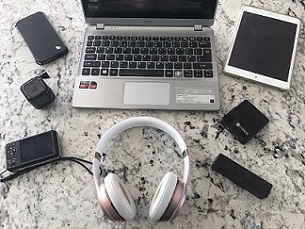 The last place you want a fire is in the confined space of an aircraft passenger cabin
The last place you want a fire is in the confined space of an aircraft passenger cabin
 An AvSax lithium-ion battery fire mitigation bag as used on thousands of passenger aircraft worldwide
An AvSax lithium-ion battery fire mitigation bag as used on thousands of passenger aircraft worldwide
 All these everyday personal electronic devices are powered by lithium-ion batteries
All these everyday personal electronic devices are powered by lithium-ion batteries
There was a time when you had to switch your mobile phone and all your other electronic devices off when on board an aircraft.
Those rules have now been relaxed as technology has moved on so it’s not the risk of using the phones that can cause problems with an aircraft, it’s more a risk of LOSING them.
If a mobile phone is accidentally dropped down a seat and the passenger moves the seat’s mechanism to try to search for it this could crush the phone, probably badly damaging the battery inside and potentially causing it to overheat and catch fire.
The biggest danger comes in First Class and Business Class where the seats recline more than most and some can even be transformed into beds.
It can and it does happen and there is always the danger a fire on board the enclosed space of an aircraft could have catastrophic results.
In the USA alone the Federal Aviation Administration has recorded 357 aviation incidents involving lithium batteries since January 2006 – so worldwide there will have been many more.
This evidence is backed up by the fact that AvSax – the world’s best-selling lithium battery fire containment bag for personal electronic devices on aircraft - are now on more than 15,373 aircraft operated by 80 airline companies. They have been used 33 times to deal with emergencies since the start of 2017 and the invention was so innovative it won the most prestigious award a business can get, the Queen’s Award for Enterprise.
So if you’ve ever wondered why cabin crew now state in the safety briefing you must let them know immediately if you lose your mobile phone, then you know why.
This safety message is recommended by the European Union Aviation Safety Agency because mobile phones are no ordinary fires – and that’s the same for any other personal electronic devices you may lose such as iPads, laptops and even earphones. If the lithium-ion battery that powers them catches fire it can go into what’s known as thermal runaway.
This happens when one cell in a battery overheats it can produce enough heat – up to 900°C (1652°F) – to cause adjacent cells to overheat. This can cause a lithium battery fire to flare repeatedly and then they are very difficult to extinguish.
Mobile phones crushed after being lost down aircraft seats have sparked more than 40 fires on planes in the last 5 years and continue to be a ‘significant hazard’ in the future.
The statistics, collated by the UK’s aviation regulator the Civil Aviation Authority, were revealed in an official report into a fire on board a British Airways Dreamliner in 2020 caused by a mobile phone being damaged by a seat.
The Air Accidents Investigation Branch report (AAIB) states: “The CAA has received 166 reports of PEDs lost in passenger seats in the last five years. A quarter of these events resulted in fire or smoke in the cabin, demonstrating that this is a significant hazard to the safety of the aircraft.”
Although airline manufacturers are trying to improve seat design to stop these kind of lithium-ion battery crush incidents from happening, it’s proving to be a challenge and none are designed to prevent electronic devices from becoming trapped in seats. That could now change.
The British Airways fire has highlighted this potentially dangerous issue again and has now led to a formal recommendation from the AAIB which states: “It is recommended that the Civil Aviation Authority require that passenger seats in commercial air transport aircraft are designed to minimise the chance of portable electronic devices becoming crushed in mechanisms.”
The fire on the British Airways flight happened when the Dreamliner – a plane designed to carry 296 passengers but only had 53 on board - was flying from Miami to London Heathrow on October 1, 2020. It was 40 minutes from landing when the passenger moved her seat from the bed position to an upright one before going to the toilet.
The flight crew quickly smelled a strong odour of sulphur, heard a hissing sound and then a large plume of smoke came from the seat in what they described as a ‘tornado’. The crew also saw an orange glow in the seat area among the smoke. They managed to bring the fire under control and the plane landed safely.
An investigation confirmed that when the seat was adjusted by the passenger it crushed and badly damaged the phone’s battery , causing smoke, flames and fumes.
Personal electronic devices (PEDs) and spare lithium-ion batteries should always be carried in hand luggage and not put in holds. If they catch fire in luggage they could quickly spark a bigger fire which automatic fire suppressant systems would struggle to contain due to the intensity of the heat and how quickly the fire could spread.